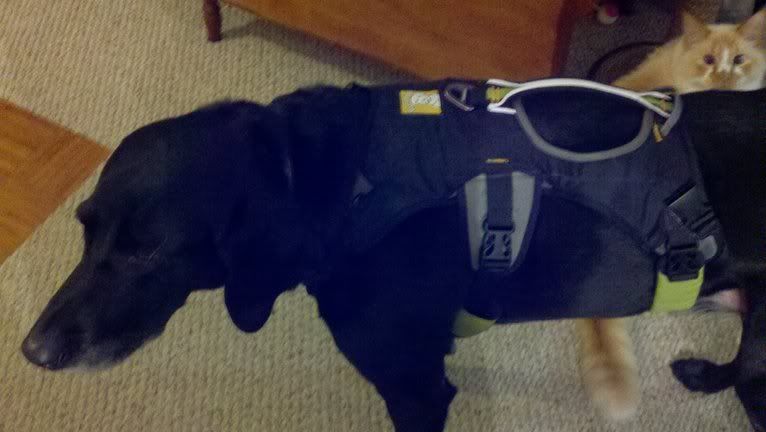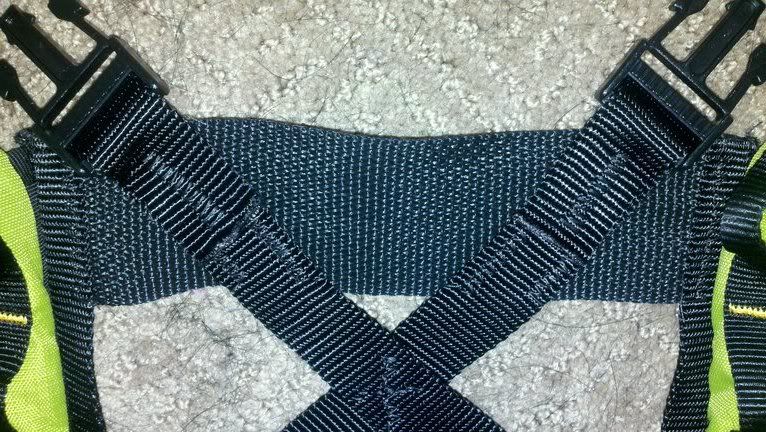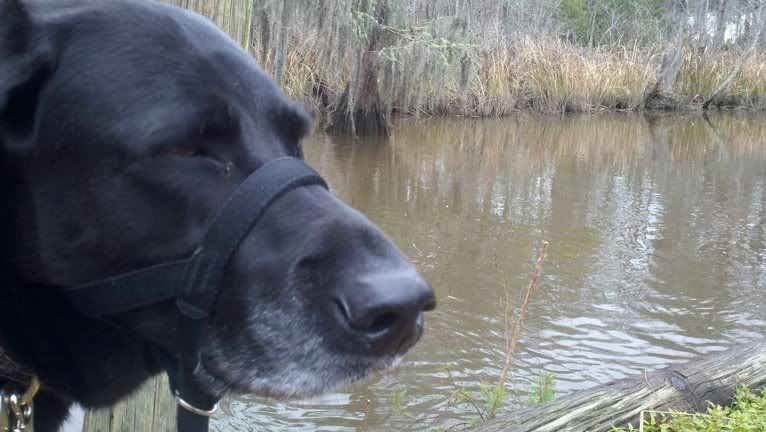 |
| Image is from Flickr.com under a Creative Commons license |
Wednesday, February 29, 2012
Guess the Genotype #54
Can you guess this dog's genotype? Its breed?
Tuesday, February 28, 2012
Crazy Plants: Sweetgum
 |
| A sweetgum (Liquidambar styraciflua), also known as sapgum, bilsted, redgum, and starleaf-gum. |
 |
| Sweetgum fruits |
 |
| The sweetgum's range |
Sources are University of Florida, Perdue University, University of Connecticut, and the USDA Forest Service. Images are from Wikimedia Commons under Creative Commons licenses: one, two, three.
Monday, February 27, 2012
Modifying Ebon's Pack
I was influenced by Losech over at The Adventures of Conker the Shiba Inu to modify Ebon's Approach pack to be more like the Palisades pack. Here's how I did it. You can find more detailed information from Losech, who modified both an Approach II (the older one) and Approach (the newer one) pack, in different ways. I used her information on the modification of the pack that's identical to Ebon's, but I changed it a bit to make sure the "tree" could handle the amount of weight I intended to place in the pack. I had a bit of an advantage because the pack's so large, so adding reinforcement was a lot easier than it would have been on one of the smaller packs. I placed the strapping in what I thought was the best orientation for the pack's size and shape, particularly to accommodate easy access to the existing handle and leash attachments. Most of the strapping placement was patterned on the existing stitching on the underlying harness.
Here are my materials, most of which were purchased at a local fabric store for right around $20:
After detaching the bags from the harness, I marked their former location with the chalk pencil and then made a pattern using measurements from the pack. Using this, I cut out three strips of two inch strapping and four strips of one-inch strapping. I then pinned them together and checked the placement of the straps in relation to the harness, as seen above. Then, I sewed it all together, checking placement on the harness as I went. I forgot to take pictures during these steps, unfortunately, but this is what it looks like finished:
I somehow managed to do this entire project without breaking a single needle, but thanks to the thickness of the materials and thread I did spend a ridiculous amount of time undoing snarls when the machine clogged. I also had to re-thread the machine about fifteen times. I didn't have time to add the snaps or reflective piping, but when I do I'll be sure to post the completely finished product.
EDIT: Decided to give some close-ups and a little more information on how and why I did some things. I sewed the entire project using a combined zig-zag and straight stitch. I known not all machines have this option, but if you want to do this sort of thing and have access to a machine that does, use it. This is the sturdiest stitch I could think of and all of the decisions I made concerning this project were about strength and durability. Ebon's a big boy, so I intend to put a lot of weight into this pack. Up to twenty pounds may be carried, and as such the pack needs to be as pretty sturdy. For the most part, anything I buy or make for my dog needs to be sturdy. I have a policy that if I can't ruin it, neither can the dog.
I actually made my strapping "tree" a bit too large, so all of the female ends of the buckles ended up being sewn right on the edge of the harness. The measurements of the "tree" are as follows: 16 1/4" long for the sides where the packs are attached, including 4" tails for the back buckles. The three cross pieces are each 8 1/2" long. For this size pack, I would suggest dropping those measurements to 15 3/4" and 8" respectively because the finished product was slightly too large. The X toward the front of the "tree" is made of two pieces, each 12 1/2" long. They were about an inch longer, but I ended up trimming that extra bit off. I decided to permanently fix all buckle parts for strength and because the one inch strapping I used is too slick for the buckles to stay in one place.
One last note: If you do this project do not forget to burn the ends of your straps. The cut ends of nylon straps look pretty neat, but unravel quite easily.
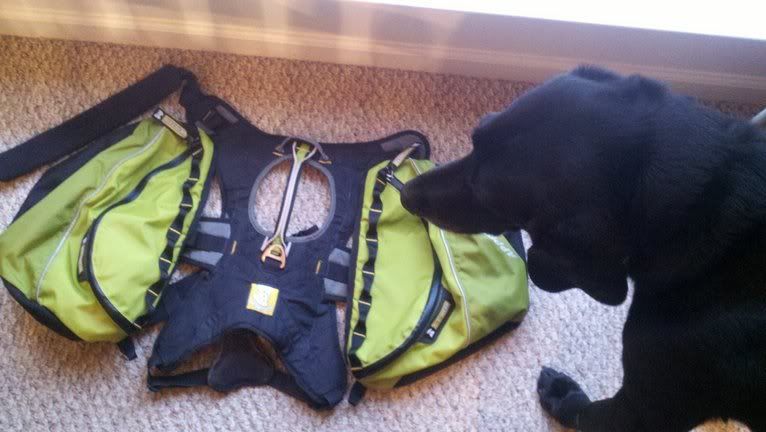 |
| Ebon with the pack, bags already removed. |
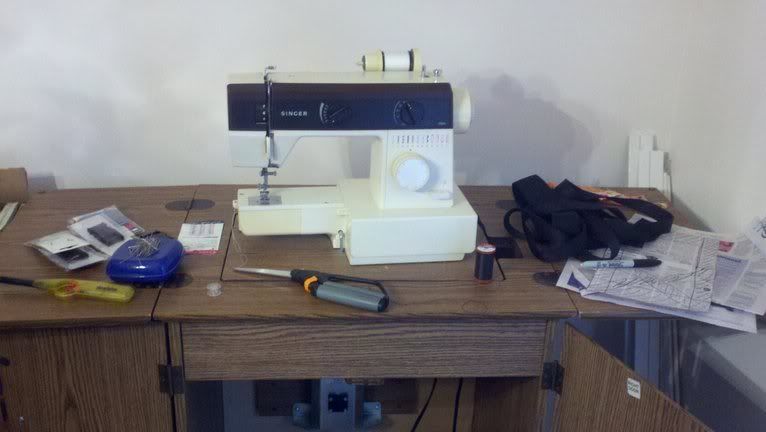 |
| All set up and ready to go. |
- Ruff Wear Approach Pack (size large)
- Sewing machine
- Four one inch plastic buckles
- Three yards of black one inch heavy-duty nylon strapping/belt material
- One yard of black two inch polypropylene strapping/belt material
- One spool black heavyweight/upholstery thread
- Size 110/18 universal heavy duty machine needles
- Pins
- Pin magnet
- Newspaper
- Sharpie marker
- Chalk pencil/Dressmaker's marking pencil
- Seam ripper
- Snaps (sew-on)
- Heavy duty hand-sewing needles
- Lighter
- Reflective piping
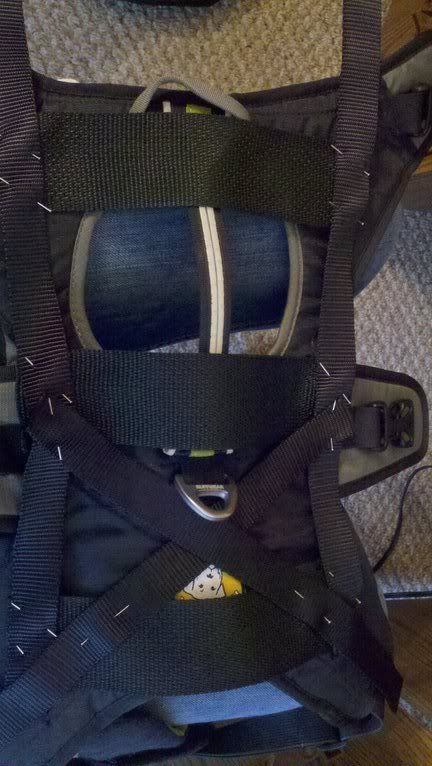 |
| Checking placement of straps. |
 |
| Tree with bags, buckled to harness. The X is toward the front. Ebon is a patient model. |
 |
| Unbuckled bags |
I somehow managed to do this entire project without breaking a single needle, but thanks to the thickness of the materials and thread I did spend a ridiculous amount of time undoing snarls when the machine clogged. I also had to re-thread the machine about fifteen times. I didn't have time to add the snaps or reflective piping, but when I do I'll be sure to post the completely finished product.
EDIT: Decided to give some close-ups and a little more information on how and why I did some things. I sewed the entire project using a combined zig-zag and straight stitch. I known not all machines have this option, but if you want to do this sort of thing and have access to a machine that does, use it. This is the sturdiest stitch I could think of and all of the decisions I made concerning this project were about strength and durability. Ebon's a big boy, so I intend to put a lot of weight into this pack. Up to twenty pounds may be carried, and as such the pack needs to be as pretty sturdy. For the most part, anything I buy or make for my dog needs to be sturdy. I have a policy that if I can't ruin it, neither can the dog.
 |
| The back buckles. I think I'm going to reinforce these tabs more because the loose ends bother me. |
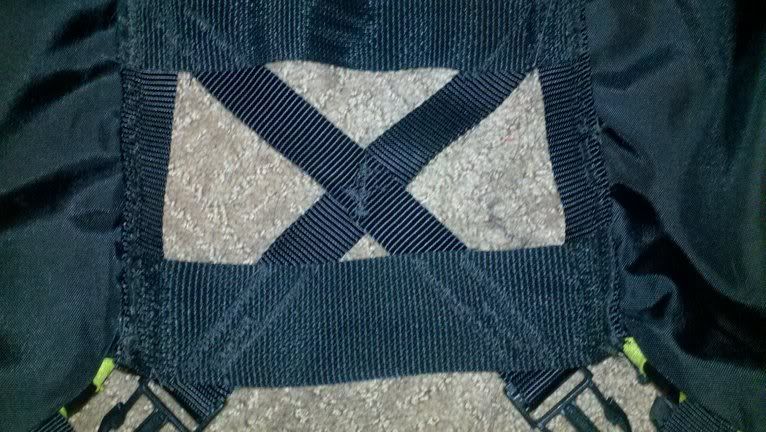 |
| The "wrong" side of the work, showing some of the messy bits from the machine getting stuck. |
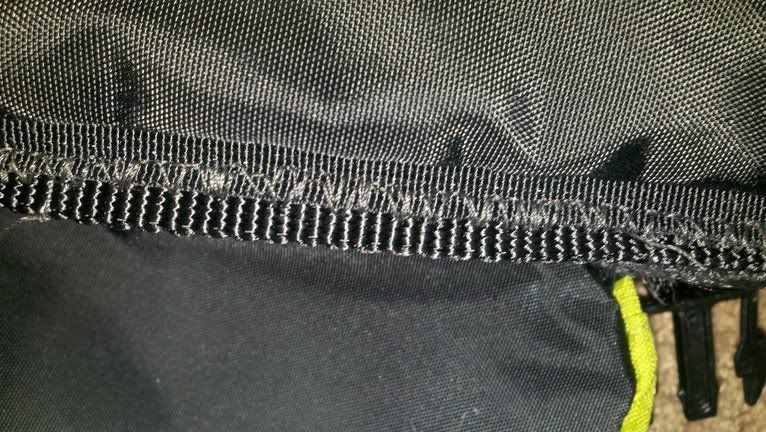 |
| The neater of the seems that attach the bags to the "tree." I suspect that I actually made the pack stronger since before the bags were attached by only a single straight seam. |
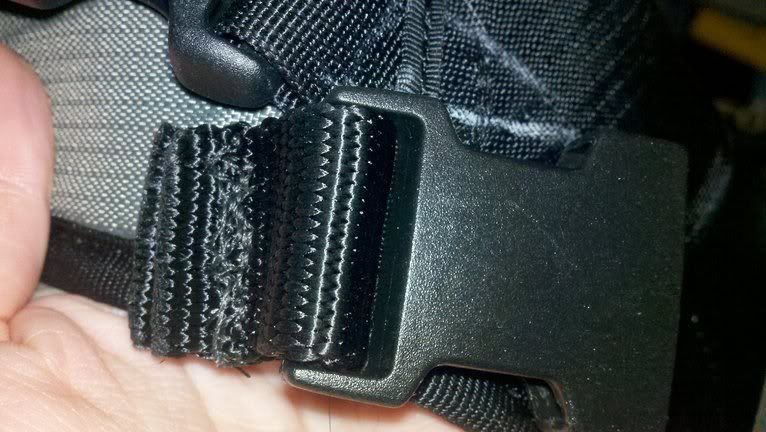 |
| One of the tabs (the neatest of them) attaching a buckle to the harness. |
One last note: If you do this project do not forget to burn the ends of your straps. The cut ends of nylon straps look pretty neat, but unravel quite easily.
Sunday, February 26, 2012
Teeth (and leg)
I thought I would do a bit of an update on Ebon, especially looking at his teeth. I posted just a little over a month ago on teeth in a dog whose primary diet is kibble. In that post, I included the following pictures:
On the seventeenth of this month, Ebon broke a tooth.
On the twentieth of this month Ebon went in and had his teeth cleaned and his broken tooth pulled. On that day he also came home with an injured leg that I've been struggling to keep him from licking raw ever since. I've posted two updates on that. What I haven't yet posted is what the rest of his teeth currently look like.
His teeth really do look lovely. All of the tartar is now gone and the socket really is healing nicely. I've been softening his food to make sure nothing would get lodged in the socket, but today I stopped that since the cavity is less than half of the size it was. The socket is a little irritated now, but that shouldn't last long. I still won't be giving him any chews until the socket is completely healed and toughened up.
As for his leg, when I went in for the follow-up check I was given a cream to apply twice daily. Though at first I was wrapping it both to stop the weeping and to keep him from licking, I'm now leaving the leg free most of the time. Since he's been off of the pain killers, he is not licking nearly as aggressively and, in fact, hasn't bothered with the leg much. When I do catch him licking, he'll stop if I ask him too, which is a bit of a relief. He actually licked his opposite foreleg so much one day that it ended up swelling rather alarmingly. A couple of hours in a compression bandage fixed that, though. The wounds are looking pretty good. Pigment is starting to come back to his skin, and some fur stubble is also beginning to appear. The only issue is that the cream I'm now putting on his leg is yellow and when it dries on his wounds, it makes them look a little...weird. Sort of sickly. However, it is only the cream.
As soon as the scabs begin to flake off I'll be comfortable with starting to take him back out on adventures. There are a couple of spots right on the margin of his pads, which are a bit tender. Hopefully those will also toughen up again quickly.
I also promise that updates will go back to being more regular. I've been spending a lot of time hovering over the dog to make sure he's being doing okay and not harming himself. Mentally I've been a bit spastic thanks to my frustration with the vet and the dog, but things are calming down.
 |
| Right canines |
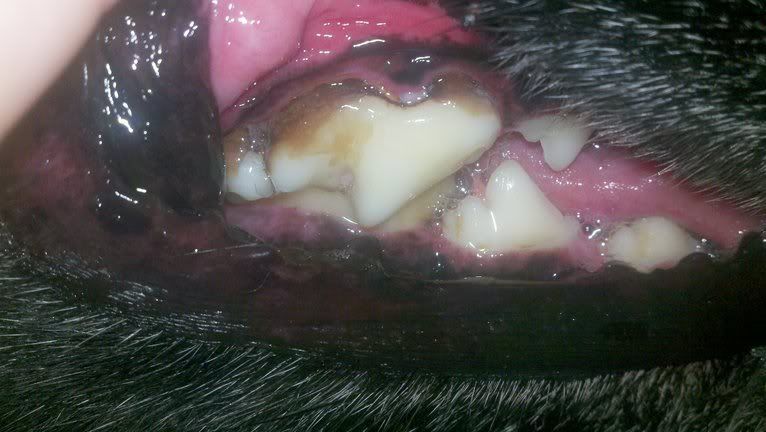 |
| Right carnasials |
 |
| Left canines |
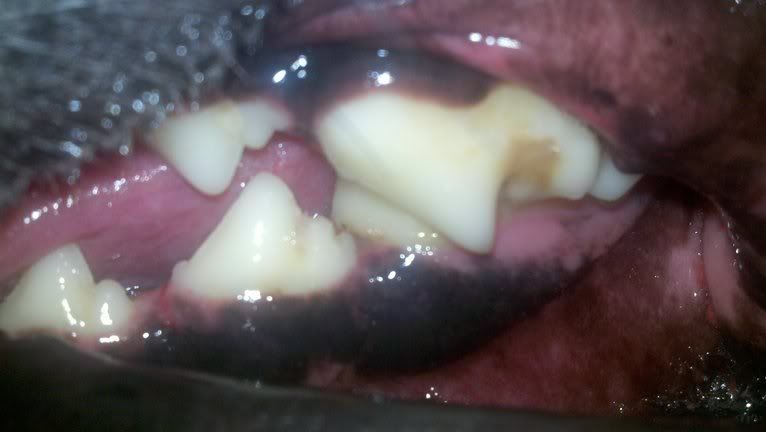 |
| Left carnassials |
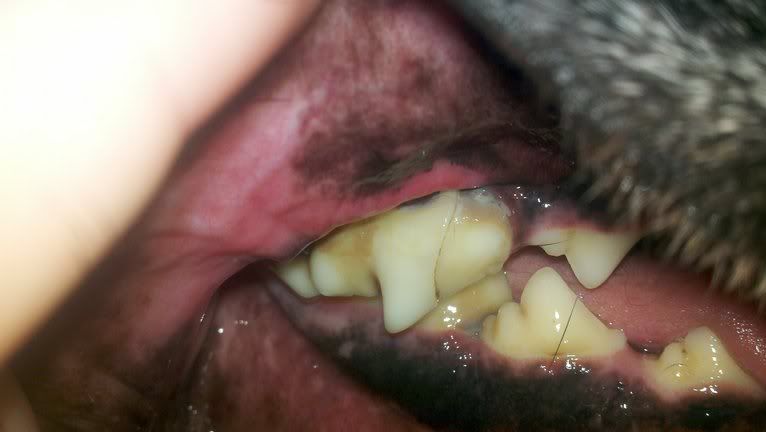 |
| Upper right carnassial, which turned out to be cracked right down the middle, opening up the pulp cavity. |
On the twentieth of this month Ebon went in and had his teeth cleaned and his broken tooth pulled. On that day he also came home with an injured leg that I've been struggling to keep him from licking raw ever since. I've posted two updates on that. What I haven't yet posted is what the rest of his teeth currently look like.
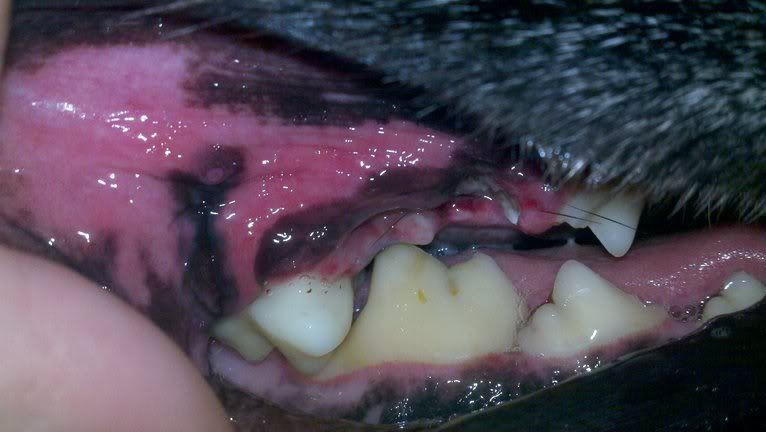 |
| Right carnassial and rapidly healing socket |
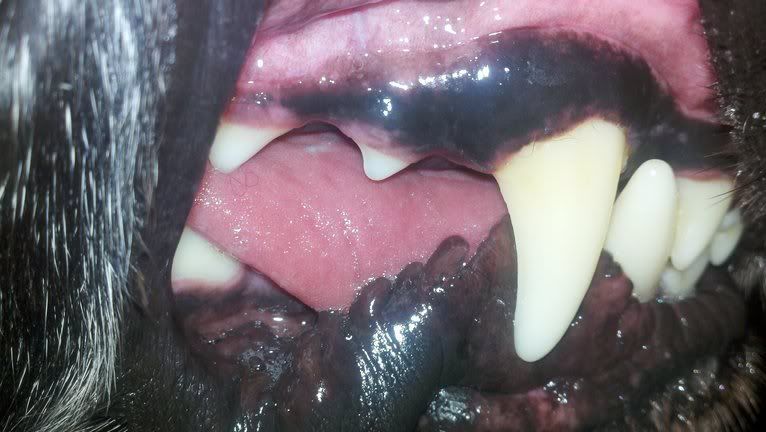 |
| Right canine |
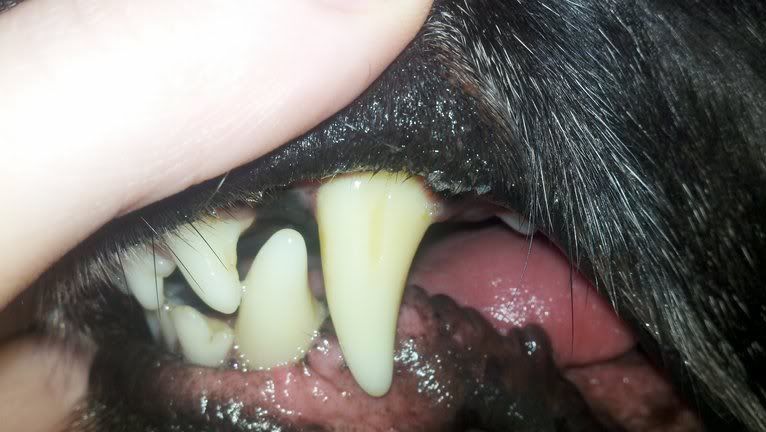 |
| Left canine |
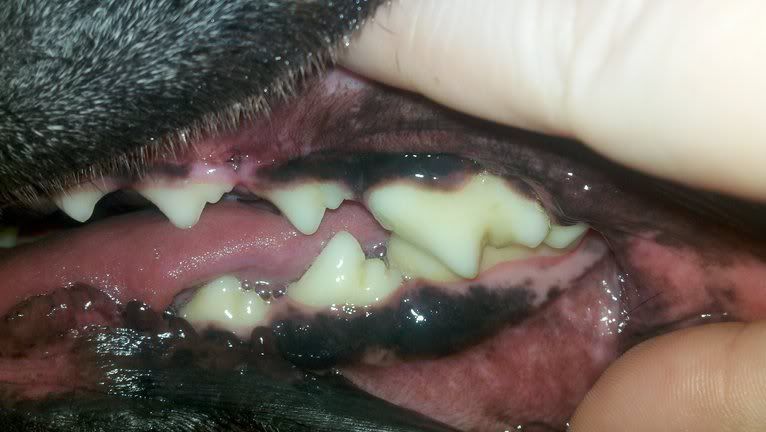 |
| Left carnassials |
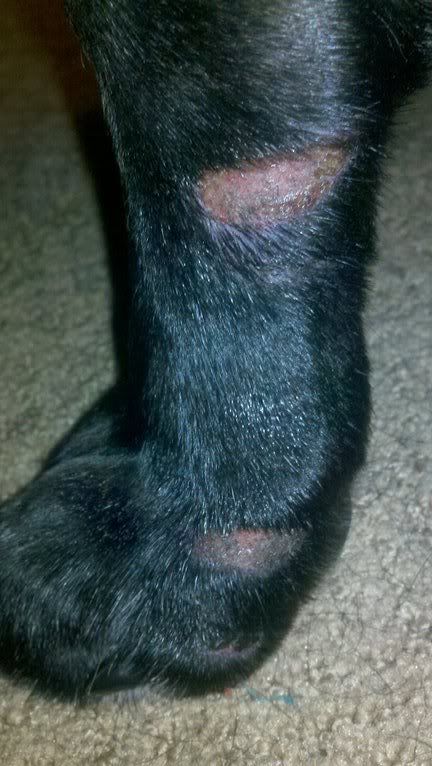 |
| His leg, looking better |
As for his leg, when I went in for the follow-up check I was given a cream to apply twice daily. Though at first I was wrapping it both to stop the weeping and to keep him from licking, I'm now leaving the leg free most of the time. Since he's been off of the pain killers, he is not licking nearly as aggressively and, in fact, hasn't bothered with the leg much. When I do catch him licking, he'll stop if I ask him too, which is a bit of a relief. He actually licked his opposite foreleg so much one day that it ended up swelling rather alarmingly. A couple of hours in a compression bandage fixed that, though. The wounds are looking pretty good. Pigment is starting to come back to his skin, and some fur stubble is also beginning to appear. The only issue is that the cream I'm now putting on his leg is yellow and when it dries on his wounds, it makes them look a little...weird. Sort of sickly. However, it is only the cream.
As soon as the scabs begin to flake off I'll be comfortable with starting to take him back out on adventures. There are a couple of spots right on the margin of his pads, which are a bit tender. Hopefully those will also toughen up again quickly.
I also promise that updates will go back to being more regular. I've been spending a lot of time hovering over the dog to make sure he's being doing okay and not harming himself. Mentally I've been a bit spastic thanks to my frustration with the vet and the dog, but things are calming down.
Saturday, February 25, 2012
Dog Food Review: Nature's Variety Instinct
This is the beginning of the dog food review series I'm doing.
Nature's Variety Instinct Duck Meal & Turkey Meal Formula
Dog Food Advisor rating: ★★★★★
This food is AAFCO approved for all life stages.
Ingredients: Duck Meal, Turkey Meal, Salmon Meal, Tapioca, Canola Oil, Tomato Pomace, Pumpkinseeds, Herring Meal, Sun-Cured Alfalfa Meal, Montmorillonite Clay, Natural Flavor, Vitamins (Choline Chloride, Vitamin E Supplement, Ascorbic Acid, Biotin, Niacin Supplement, Vitamin A Acetate, d-Calcium Pantothenate, Riboflavin Supplement, Pyridoxine Hydrochloride, Thiamine Mononitrate, Vitamin B12 Supplement, Carotene, Vitamin D3 Supplement, Folic Acid), Potassium Chloride, Minerals (Zinc Proteinate, Iron Proteinate, Manganese Proteinate, Copper Proteinate, Sodium Selenite, Ethylenediamine Dihydriodide), Sea Salt, Dried Kelp, Peas, Cranberries, Blueberries, Direct-Fed Microorganisms (Saccharomyces Cerevisiae Yeast Culture, Dried Enterococcus Faecium Fermentation Product, Dried Lactobacillus Acidophilus Fermentation Product, Dried Aspergillus Niger Fermentation Extract, Dried Trichoderma Longibrachiatum Fermentation Extract, Dried Bacillus Subtilis Fermentation Extract), Inulin, Mixed Tocopherols with Citric Acid (a natural preservative), Rosemary Extract, Freeze Dried Turkey, Freeze Dried Turkey Liver, Freeze Dried Turkey Heart, Freeze Dried Ground Turkey Bone.
Items in italics will be discussed later.
Bag's recommended daily feeding instructions for an active dog 51-100 lbs: 2 5/8 - 4 1/8 cups
Crude Protein: minimum of 35.0%
Crude Fat: minimum of 22.0%
Crude Fiber: maximum of 3.5%
Moisture: maximum of 10.0%
Calorie content: 464 kcal/cup, 3,893 kcal/kg
Calculated amount to maintain Ebon's ideal weight (82.5 lbs): 3.59 cups or 0.43 kg (0.946 lbs)
Price per pound when buying the largest bag (25.3 lbs at $58.99): $2.332
Estimated cost of feeding Ebon per year on this food: $805.09 (13.65 of the 25.3 lb bags)
Ebon receives slightly less than the calculated feeding amount to allow for his daily treats
Ebon's overall health on this food: Very good. His coat is shiny, poop compact and very consistent, energy level moderate to high.
I started transitioning from Ebon's old food on February 6th, and I just started transitioning him off of this food. Though his dental crisis did interrupt this review a bit, he was still on the food more than long enough to get a good sense of how he did on it. I continued the diet and softened the food, through this discovering that it produces a rather nice gravy when you add a bit of water.
The kibble itself is variable in size, which I found interesting. Most brands I've seen have a consistent size and shape. In fact, the bag has a picture of the kibble at its "actual size" and, though it looks consistent, the kibble inside of the bag is definitely not (some kibble being twice the size of other kibble).
This kibble is very heavy in meat content, as seen in the first three ingredients. The brand also boasts a freeze dried raw coating on the outside of the kibble, which is reflected in the ingredients list. In this case, that coating is made entirely of turkey parts. Ebon got very excited at the smell of this food, which is likely thanks to the high meat content and the outer coating.
Some nice things to see in this food: chelated minerals and probiotics. Chelated minerals are believed to be more easily absorbed and used by the body than non-chelated minerals, and probiotics/microorganisms help maintain good gut flora to provide for better digestion. One ingredient that some people may find distressing is Montmorillonite Clay. Yes, that's right: clay. However, clay isn't necessarily a thing to be scoffed at. For one thing, this clay is known for its mineral content and is also reportedly effective at absorbing harmful toxins (such as the mold-produced ones sometimes found in contaminated grain) and keeping stool consistent. Since Ebon's stoll can become loose when he is stressed (not diarrhea, just loose), it was very interesting to see the effects of the inclusion of this clay. This food did help keep his stool consistent, despite such things as being placed under anesthesia for his dental. The last time he was put under, he had very runny stools for a day. This time, no problems.
Ebon's coat has also been better, with more shine and less dandruff. His skin tends to become a bit dry after his monthly bath, but this time it wasn't anywhere near as big of an issue. His energy level has been about the same if you exclude the days he was on painkillers following his dental. He seems to really enjoy the food. As I mentioned before, he became very excited as soon as I opened the bag. The days where I softened the food didn't change this at all, and it even seemed like the gravy may have made him more enthusiastic.
I was quite happy with how Ebon did on this food. I was especially happy with the state of his poop because, honestly, it's more than a bit frustrating when his anxiety causes goopy poop. I didn't mind it as much where I was living before, where it was a rural area and I only picked up his poop immediately if he went in a public area or on someone's lawn. But where I am now I have to pick up his poop every time or I could be fined. The softer the poop, the more difficult to deal with, particularly when fresh. However, this food is quite pricey, especially when compared to what he was eating before. Plus, his old food (Simply Nourish) provided far more consistent poop than what he was eating before that (Blue Buffalo Life Protection) and the changes in his overall health between Simply Nourish and Nature's Variety Instinct weren't that major.
Will I change foods? We'll see. More reviews are to come. Next up: Taste of the Wild.
Nature's Variety Instinct Duck Meal & Turkey Meal Formula
Dog Food Advisor rating: ★★★★★
This food is AAFCO approved for all life stages.
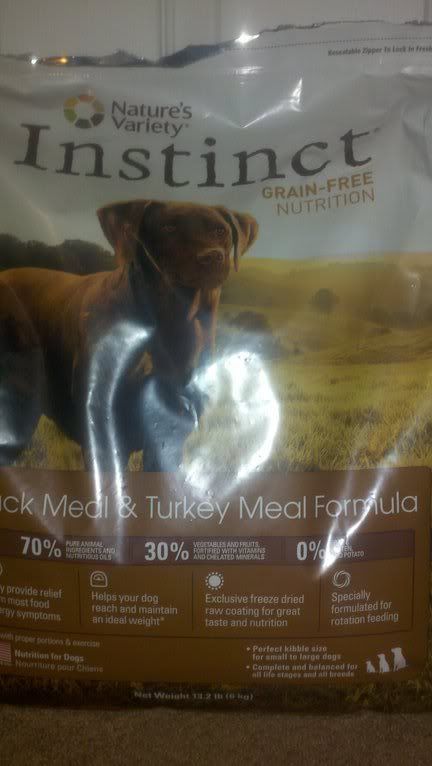 |
| The bag |
Items in italics will be discussed later.
Bag's recommended daily feeding instructions for an active dog 51-100 lbs: 2 5/8 - 4 1/8 cups
Crude Protein: minimum of 35.0%
Crude Fat: minimum of 22.0%
Crude Fiber: maximum of 3.5%
Moisture: maximum of 10.0%
Calorie content: 464 kcal/cup, 3,893 kcal/kg
Calculated amount to maintain Ebon's ideal weight (82.5 lbs): 3.59 cups or 0.43 kg (0.946 lbs)
Price per pound when buying the largest bag (25.3 lbs at $58.99): $2.332
Estimated cost of feeding Ebon per year on this food: $805.09 (13.65 of the 25.3 lb bags)
Ebon receives slightly less than the calculated feeding amount to allow for his daily treats
Ebon's overall health on this food: Very good. His coat is shiny, poop compact and very consistent, energy level moderate to high.
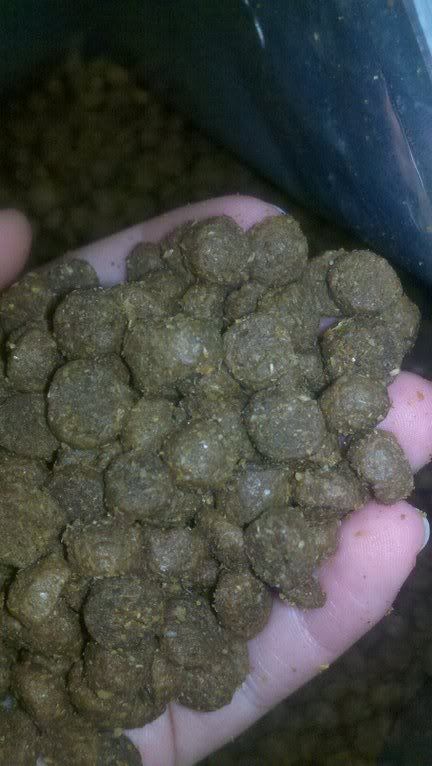 |
| The kibble |
The kibble itself is variable in size, which I found interesting. Most brands I've seen have a consistent size and shape. In fact, the bag has a picture of the kibble at its "actual size" and, though it looks consistent, the kibble inside of the bag is definitely not (some kibble being twice the size of other kibble).
This kibble is very heavy in meat content, as seen in the first three ingredients. The brand also boasts a freeze dried raw coating on the outside of the kibble, which is reflected in the ingredients list. In this case, that coating is made entirely of turkey parts. Ebon got very excited at the smell of this food, which is likely thanks to the high meat content and the outer coating.
Some nice things to see in this food: chelated minerals and probiotics. Chelated minerals are believed to be more easily absorbed and used by the body than non-chelated minerals, and probiotics/microorganisms help maintain good gut flora to provide for better digestion. One ingredient that some people may find distressing is Montmorillonite Clay. Yes, that's right: clay. However, clay isn't necessarily a thing to be scoffed at. For one thing, this clay is known for its mineral content and is also reportedly effective at absorbing harmful toxins (such as the mold-produced ones sometimes found in contaminated grain) and keeping stool consistent. Since Ebon's stoll can become loose when he is stressed (not diarrhea, just loose), it was very interesting to see the effects of the inclusion of this clay. This food did help keep his stool consistent, despite such things as being placed under anesthesia for his dental. The last time he was put under, he had very runny stools for a day. This time, no problems.
Ebon's coat has also been better, with more shine and less dandruff. His skin tends to become a bit dry after his monthly bath, but this time it wasn't anywhere near as big of an issue. His energy level has been about the same if you exclude the days he was on painkillers following his dental. He seems to really enjoy the food. As I mentioned before, he became very excited as soon as I opened the bag. The days where I softened the food didn't change this at all, and it even seemed like the gravy may have made him more enthusiastic.
I was quite happy with how Ebon did on this food. I was especially happy with the state of his poop because, honestly, it's more than a bit frustrating when his anxiety causes goopy poop. I didn't mind it as much where I was living before, where it was a rural area and I only picked up his poop immediately if he went in a public area or on someone's lawn. But where I am now I have to pick up his poop every time or I could be fined. The softer the poop, the more difficult to deal with, particularly when fresh. However, this food is quite pricey, especially when compared to what he was eating before. Plus, his old food (Simply Nourish) provided far more consistent poop than what he was eating before that (Blue Buffalo Life Protection) and the changes in his overall health between Simply Nourish and Nature's Variety Instinct weren't that major.
Will I change foods? We'll see. More reviews are to come. Next up: Taste of the Wild.
Friday, February 24, 2012
Guess the Genotype #53
Can you guess these dog's genotypes? Their breeds?
 |
| Image from Flickr.com under a Creative Commons license |
Wednesday, February 22, 2012
Ebon's Upset with Me
 |
| The look of disapproval. |
Tuesday, February 21, 2012
Mismark Case Study: Doberman Pinscher
 |
| Doberman pinschers in the breed's most commonly seen color: black and rust. Image from Flickr.com under a Creative Commons license. |
- Too much white
- Anything more than a small spot on the chest
- Not enough tan
- If any of the normal tan/rust markings are not present
- Solid colors
- Such as the unusual, but possible solid red
- Albino (white)
- Appears as cream with white points
 |
| A Doberman with too much white |
 |
| This Doberman is missing some tan |
Solid colors in the breed are really quite unusual. However, that doesn't mean they don't exist. The occasional solid red Doberman is born, and the origin of the color goes back to the use of such breeds as the German pinscher in the Doberman's creation. German pinschers are known for coming in two forms of solid red: stag red and clear red. Stag red is caused by the sable gene while clear red is caused by the recessive red gene. While Dobermans are fixed for the tan point gene and thus cannot be sable, it is very possible for some Dobermans to carry the recessive red gene. Clearly, some do because some solid reds have been born. Since the gene is recessive, it cannot really be bred out unless genetic testing is done, and, honestly, why do that? Eliminating all dog carrying recessive red from the gene pool would only decrease genetic diversity and potentially cause problems.
 |
| This Doberman is white |
 |
| This fawn Doberman has dilution alopecia |
All in all, the Doberman pinscher was originally meant to be a working breed. In a working breed, capability to do the job is far more important than looks. As such, why does it matter if a dog has two inches of white on its chest? A dog needs to be sound more-so than anything else to be able to do the sort of jobs that Dobermans were first bred for. Also, now most Dobermans are not used as working dogs. Most end up being pets, which means that temperament and health should be the first concerns of every Doberman breeder. However, if these breeders also want to maintain the idea of the Doberman as a working breed, why should color, of all things, matter?
Monday, February 20, 2012
Guess the Genotype #52
Can you guess this dog's genotype? Its breed?
 |
| Image is from Wikimedia Commons under a Creative Commons license |
Vet Day
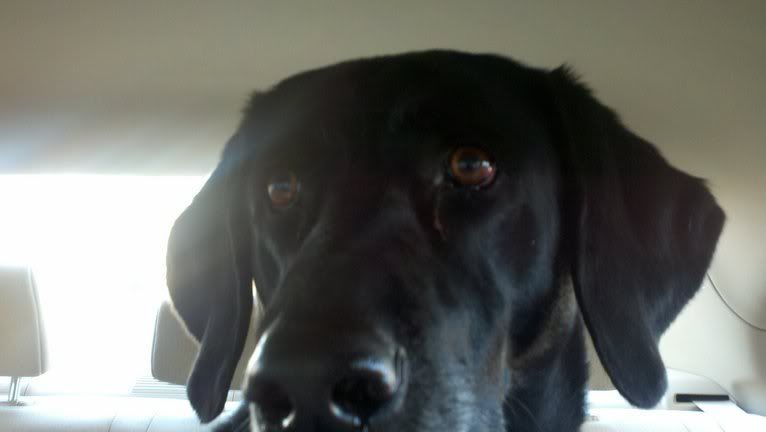 |
| Ebon in the car right outside the vet |
Dropped Ebon off at the vet at 8:00 am. Since he wasn't allowed to eat last night or this morning the poor fellow was acting very confused about being without. Still don't know whether the tooth will stay or not, but I'll be finding out what the vet thinks is the best decision soon.
EDIT: The tooth has been pulled.
EDIT #2: Ebon seems to be doing well. His teeth are beautiful and the socked from the pulled tooth looks good (If you're curious and don't mind a little blood, here's a picture). However, I discovered upon arrival home that some time during the eight hours Ebon spent at the vet today his leg was injured rather badly. Best as one of the vets can determine (not the one who actually worked on Ebon, mind you), he moved while still under sedation and scraped his leg against the concrete floor of the recovery area. The wounds don't look chewed and the skin seems to me to have been pulled off (again, same as above, here's a picture, and another). What really steams me up is the fact that the people working there failed to notice the injuries and likely resultant bloody mess. I understand that he had a tooth pulled and they bleed, but ugh.
My brother was kind enough to sacrifice a sock at help me clean and bandage the wounds. I was a bit thorough in making sure that he wouldn't lick or chew the spots, so there is ointmented gauze taped to his leg, covered by a sock and finally wrapped in an ace bandage. He's currently sleeping.
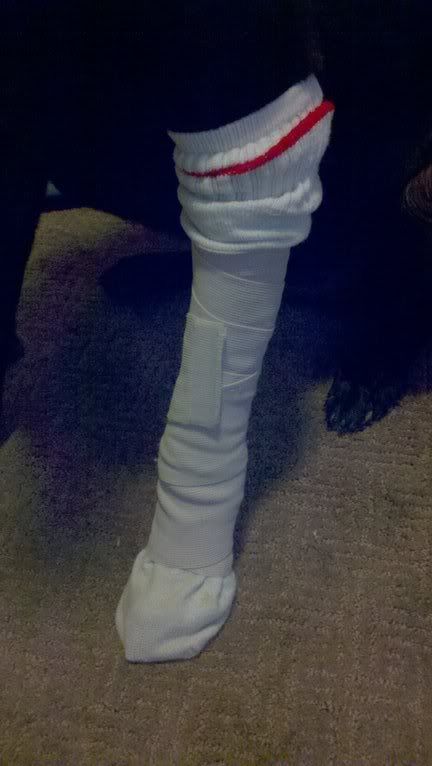 |
| Ebon's makeshift bandage. |
Saturday, February 18, 2012
Tooth Update
Friday, February 17, 2012
Interesting Animals: Snow Leopard
 |
| A snow leopard (Uncia uncia) in the wild. |
 |
| The snow leopard's range |
 |
| A captive snow leopard |
Sources are the University of Michigan Museum of Zoology's Animal Diversity Web and the IUCN Red List of Threatened species. Images are from Wikimedia Commons and are under a Creative Commons license or are copyright free: one, two, three.
Well, Shit
Ebon just cracked a tooth. I'm not kidding either, it literally just happened. I gave him the second half of the Churpi Chew I bought a short time ago about ten minutes ago. As I've gotten into the habit of lately, I checked his teeth when he finished and discovered this:
Luckily, his dental appointment is this Monday, but I don't even know if the tooth is salvageable. I'm going to be softening his food until it can be taken care of.
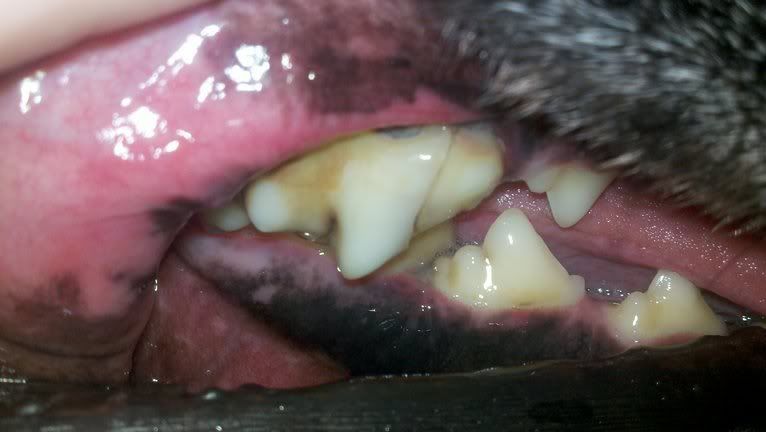 |
| That's a crack, all right, and from what I can tell it goes very deep, possibly down to the pulp. |
Luckily, his dental appointment is this Monday, but I don't even know if the tooth is salvageable. I'm going to be softening his food until it can be taken care of.
Thursday, February 16, 2012
Phylum Cnidaria
 |
| Moon jellyfish, one of the numerous species of cnidarian. |
 |
| How a nematocyst fires |
Cnidarians are a simple sort of animal, not even having a complete digestive tract. Their mouth also serves the same purpose as the anus found in other animals. This makes digestion someone inefficient since opening its mouth to ingest new food can cause the animal to loose a fair amount of partially digested food and any potential energy it could obtain from it. The do have a simple nerve net, muscle tissue, sensory organs, and numerous other things that the previously mentioned phyla do not have.
 |
| Medusa (left) and polyp (right) |
There are a number of Classes within this phylum: Scyphozoa, Cubozoa, Hydrozoa, Myxozoa, and Anthozoa. Class Scyphozoa includes those jellyfish that virtually everyone knows about. They alternate between medusa and polyp, and one of their most distinguishing characteristics is their use of strobilation. Some in this group have zooxanthellae, or algae that live within the animal's tissue. Class Cubozoa is the box jellyfish, which are rather infamous for their painful sting. Their medusae are box-like and they also, believe it or not, have complex eyes with lenses. They have polyps and medusae, but do not strobilate. Class hydrozoa includes such species as the hyrda and unique colonials like the Portugese man-of-war. These species have a life cycle that is dominated by the polyp rather than the medusa. Class Myxozoa consists of strange parasites that I won't talk about for simplicity's sake. Class Anthozoa includes all of the corals and the anemones, polyp-only species that may be colonial (coral) or singular (anemones).
I could go on forever about the differences between they types and such, but I'm going to cut it short here.
Source is Biology of the Invertebrates. Images are from Wikimedia Commons and are under a Creative Commons license or are copyright free: one, two, three.
Wednesday, February 15, 2012
Overcast Park Day (more pictures)
It's been extremely dreary lately, overcast nearly every day for many days. Lots of rain and skies threatening rain. That's why the recent pictures look the way that they do. It actually rained a bit during both of the days I was on campus. Today, I forgot to bring my rain coat to the park and thankfully there was no rain. It's supposed to stay like this for four more days. I'm starting to miss the sun. This winter's been very warm, and it seems that the least the weather could do was give us some sun.
Anyway, I took Ebon to the old rice farm. I did the whole trail, unlike last time where the sun was against us and I hadn't brought a flashlight. We did some running. I don't have a lot of endurance, though (I let myself get out of shape), so it was in fits and spurts. Plus I discovered I can't really run yet on gravel while wearing my Five Fingers. Most of the trail is paved but two section are not, these sections being made of gravel instead. It's an interesting sort of perspective wearing the Five Fingers because you get a real sense of the terrain and what is and is not comfortable for a dog to walk on. Ebon has a habit of weaving on gravel, and I hadn't thought about it before. I figure it's because it hurts his paws and he's trying to find a better place to walk. We ended up walking in the tire tracks on the trail, me in one and him in the other because it was far more comfortable.
We met several dogs on the trail, most of whom were overexcited sorts, which send Ebon into a sort of anxious whining fit because he thinks it means it's time to play. I'm working on desensitizing him so that he'll stop, but unfortunately not everyone is cooperative about these sorts of things. For example, Ebon and I met a woman and her dog, a male chocolate Labrador named Moose. When we were still a bit of a distance away I told her I was training Ebon to be calmer, but she walked right up to us anyway and Moose ended up getting the four of us all tangled together. It's usually nice that people in the area are so friendly, but sometimes it's frustrating.
Anyway, I took Ebon to the old rice farm. I did the whole trail, unlike last time where the sun was against us and I hadn't brought a flashlight. We did some running. I don't have a lot of endurance, though (I let myself get out of shape), so it was in fits and spurts. Plus I discovered I can't really run yet on gravel while wearing my Five Fingers. Most of the trail is paved but two section are not, these sections being made of gravel instead. It's an interesting sort of perspective wearing the Five Fingers because you get a real sense of the terrain and what is and is not comfortable for a dog to walk on. Ebon has a habit of weaving on gravel, and I hadn't thought about it before. I figure it's because it hurts his paws and he's trying to find a better place to walk. We ended up walking in the tire tracks on the trail, me in one and him in the other because it was far more comfortable.
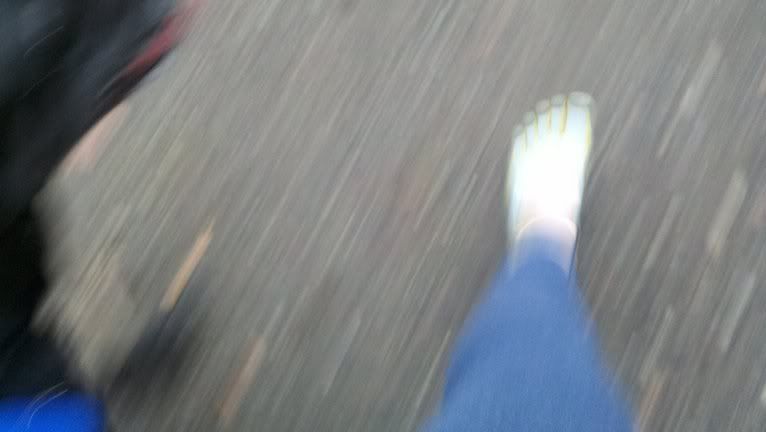 |
| On the move |
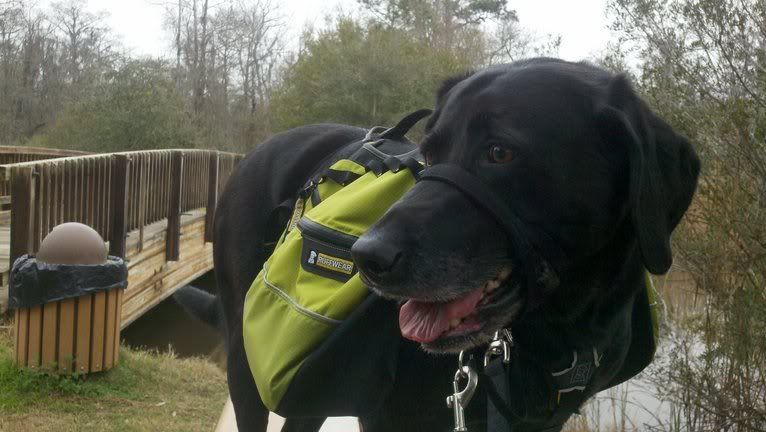 |
| On this side of the bridge the path is paved. On the other side it's gravel. |
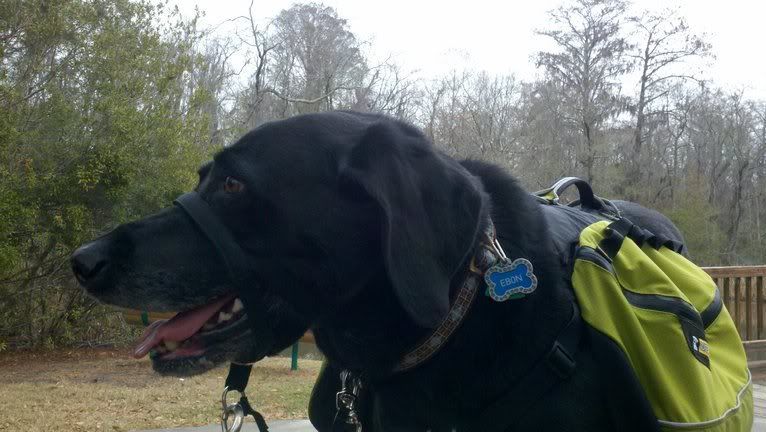 |
| He's on another picnic table here. |
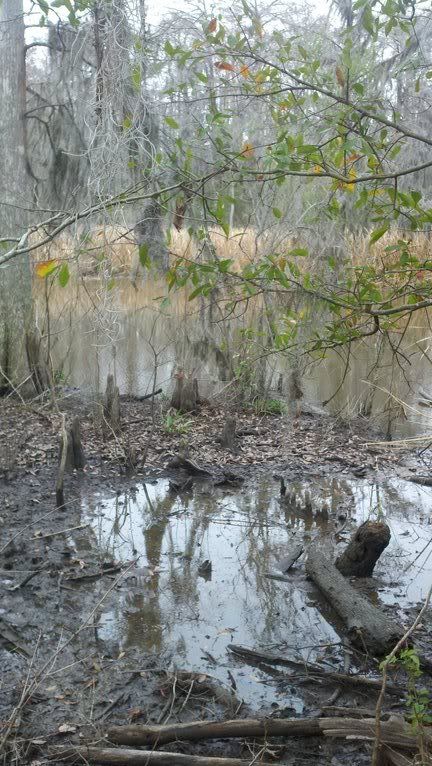 |
| The park's kind of a marsh-swamp. I'm going to call it a mamp. It has many plants that are classically associated with a swamp, but it's tidal, which I don't really associate with a swamp. |
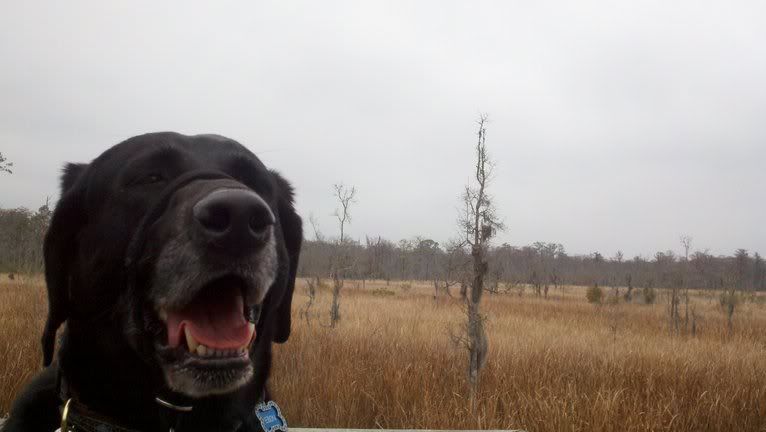 |
| From the observation tower again. |
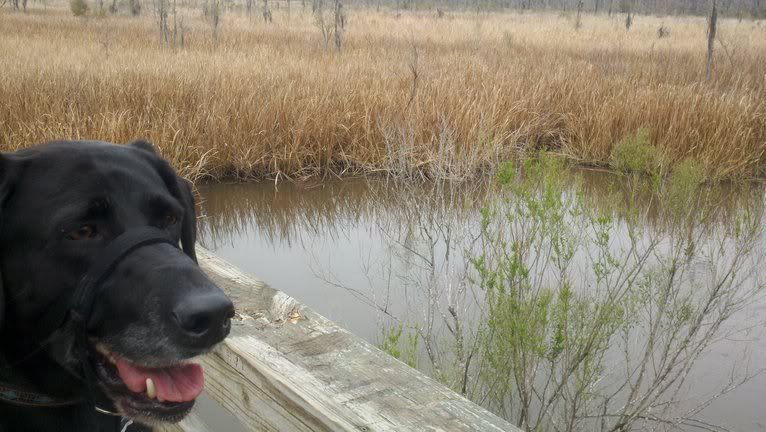 |
| More view of the high tide. |
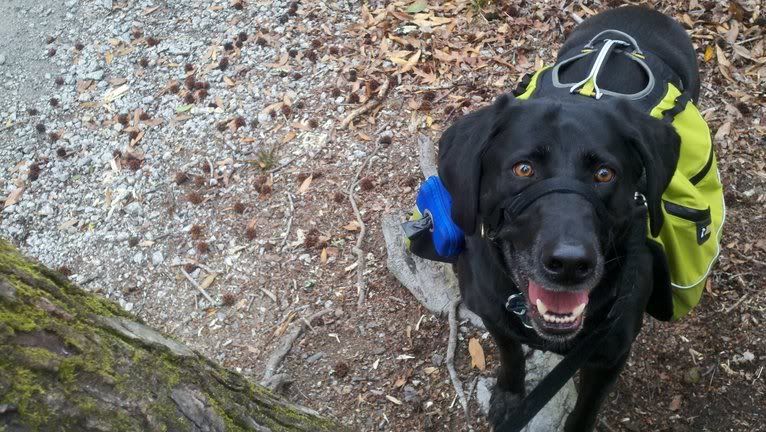 |
| I climbed another tree while we were there too. |
Subscribe to:
Posts (Atom)

